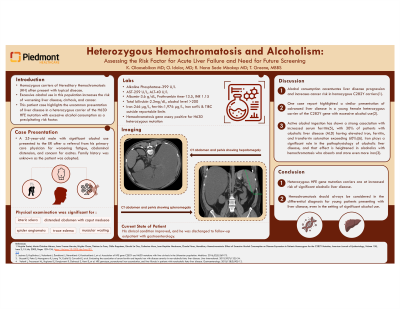Tuesday Poster Session
Category: Liver
P4003 - Heterozygous Hemochromatosis & Alcoholism: Assessing the Risk of Acute Liver Failure and the Need for Future Screening
Tuesday, October 24, 2023
10:30 AM - 4:00 PM PT
Location: Exhibit Hall


Kikelomo Olaosebikan, MD
Piedmont Athens Regional Medical Center
Athens, GA
Presenting Author(s)
Kikelomo Olaosebikan, MD1, Osahon Idolor, MD2, Raissa Nana Sede Mbakop, MD1, Tayla Greene, MBBS1
1Piedmont Athens Regional Medical Center, Athens, GA; 2Piedmont Athens Regional, Athens, GA
Introduction: Homozygous carriers of Hereditary Hemochromatosis (HH) often present with specific diseases. Excessive alcohol use in this population increases the risk of worsening liver disease, cirrhosis, and cancer. Limited research has been available regarding the effects of alcohol abuse on heterozygous hemochromatosis(HFE) gene mutation carriers. This patient case highlights the uncommon presentation of liver disease in a heterozygous carrier of the H63D HFE mutation with excessive alcohol consumption as a precipitating risk factor.
Case Description/Methods: A 25-year-old male with a history of alcohol use disorder who presented to the Emergency Room with symptoms of fatigue, abdominal distension, and concern for ascites. Family history was unknown as the patient was adopted. Physical examination revealed icteric sclera, a distended abdomen with caput-medusae and spider angiomata, and muscular wasting. Laboratory results showed elevated liver enzymes, alkaline phosphatase, total bilirubin, and high iron and ferritin levels. The patient was found to be a heterozygous carrier of the H63D HFE gene mutation associated with hereditary HH. Abdominal imaging showed severe hepatomegaly, and splenomegaly. Clinical condition improved, and he was discharged with appropriate follow-ups
Discussion: HH is characterized by iron overload, with phenotypic variability determined by several factors. Alcohol consumption accentuates liver disease progression and increases cancer risk in homozygous C282Y carriers. However, less data is available regarding the relationship between alcohol use and disease progression in heterozygous gene mutation carriers, especially in younger patients. One case report highlighted a similar presentation of advanced liver disease in a young heterozygous carrier of the C282Y gene with excessive alcohol use. One study noted that while hepatocellular iron accumulation occurs predominantly in HFE mutations, there was no increased prevalence of fibrosis severity associated with particular HFE genotypes. Active alcohol use has shown a strong association with a high serum ferritin, with 30% of patients with alcoholic liver disease having elevated iron, ferritin, and transferrin saturation. Iron plays a significant role in the pathophysiology of alcoholic liver disease, and that effect is heightened with hemochromatosis. Therefore, Hemochromatosis should always be considered in the differential diagnosis for young patients presenting with liver disease, even in the setting of significant alcohol use.
Disclosures:
Kikelomo Olaosebikan, MD1, Osahon Idolor, MD2, Raissa Nana Sede Mbakop, MD1, Tayla Greene, MBBS1. P4003 - Heterozygous Hemochromatosis & Alcoholism: Assessing the Risk of Acute Liver Failure and the Need for Future Screening, ACG 2023 Annual Scientific Meeting Abstracts. Vancouver, BC, Canada: American College of Gastroenterology.
1Piedmont Athens Regional Medical Center, Athens, GA; 2Piedmont Athens Regional, Athens, GA
Introduction: Homozygous carriers of Hereditary Hemochromatosis (HH) often present with specific diseases. Excessive alcohol use in this population increases the risk of worsening liver disease, cirrhosis, and cancer. Limited research has been available regarding the effects of alcohol abuse on heterozygous hemochromatosis(HFE) gene mutation carriers. This patient case highlights the uncommon presentation of liver disease in a heterozygous carrier of the H63D HFE mutation with excessive alcohol consumption as a precipitating risk factor.
Case Description/Methods: A 25-year-old male with a history of alcohol use disorder who presented to the Emergency Room with symptoms of fatigue, abdominal distension, and concern for ascites. Family history was unknown as the patient was adopted. Physical examination revealed icteric sclera, a distended abdomen with caput-medusae and spider angiomata, and muscular wasting. Laboratory results showed elevated liver enzymes, alkaline phosphatase, total bilirubin, and high iron and ferritin levels. The patient was found to be a heterozygous carrier of the H63D HFE gene mutation associated with hereditary HH. Abdominal imaging showed severe hepatomegaly, and splenomegaly. Clinical condition improved, and he was discharged with appropriate follow-ups
Discussion: HH is characterized by iron overload, with phenotypic variability determined by several factors. Alcohol consumption accentuates liver disease progression and increases cancer risk in homozygous C282Y carriers. However, less data is available regarding the relationship between alcohol use and disease progression in heterozygous gene mutation carriers, especially in younger patients. One case report highlighted a similar presentation of advanced liver disease in a young heterozygous carrier of the C282Y gene with excessive alcohol use. One study noted that while hepatocellular iron accumulation occurs predominantly in HFE mutations, there was no increased prevalence of fibrosis severity associated with particular HFE genotypes. Active alcohol use has shown a strong association with a high serum ferritin, with 30% of patients with alcoholic liver disease having elevated iron, ferritin, and transferrin saturation. Iron plays a significant role in the pathophysiology of alcoholic liver disease, and that effect is heightened with hemochromatosis. Therefore, Hemochromatosis should always be considered in the differential diagnosis for young patients presenting with liver disease, even in the setting of significant alcohol use.
Disclosures:
Kikelomo Olaosebikan indicated no relevant financial relationships.
Osahon Idolor indicated no relevant financial relationships.
Raissa Nana Sede Mbakop indicated no relevant financial relationships.
Tayla Greene indicated no relevant financial relationships.
Kikelomo Olaosebikan, MD1, Osahon Idolor, MD2, Raissa Nana Sede Mbakop, MD1, Tayla Greene, MBBS1. P4003 - Heterozygous Hemochromatosis & Alcoholism: Assessing the Risk of Acute Liver Failure and the Need for Future Screening, ACG 2023 Annual Scientific Meeting Abstracts. Vancouver, BC, Canada: American College of Gastroenterology.
